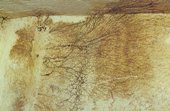Cellar rot fungus (Coniphora puteana)
The brown cellar rot fungus is one of the most important wood-destroying fungi is buildings, besides dry rot. It does not only occur in buildings, but can be found in stored timber, wood with ground contact (such as utility poles, railway sleepers) and wooden structures (like bridges). It attacks both coniferous and deciduous timbers.
In contrast to true dry rot, brown cellar rot requires higher levels of wood moisture for optimum growth and appears to react more sensitively to drying, as it doesn’t form a protective surface mycelium.
What does it look like?
Young cellar rot fruit bodies are white, but in the course of their growth, they develop a layer of brown spores in the middle. The fruit body is normally about 2 mm thick, with characteristic brown protuberances on the surface, similar to warts, (which is why the fungus is referred to as “wart rot” in German).
Brown cellar rot forms fine fungal strands, which are white to begin with, but turn black later in their development. This mycelium of fungal strands that spreads across woodwork and masonry is similar in appearance to the root networks of plants.
What damage can it do?
If growing conditions are favourable, brown cellar rot can cause as much serious damage as true dry rot. In laboratory tests, it grows faster than dry rot and consequently is used for testing the biological efficacy of wood preservatives.
What can be done to combat cellar rot?
Active infestation with the cellar rot fungus must be tackled thoroughly. Fungal determination and assessment of the infestation must be carried out by an expert. The basis for curative treatment of fungal infestation in Germany is the wood preservation standard DIN 68800 part 4 “Wood preservation; measures for the eradication of fungi and insects”.
